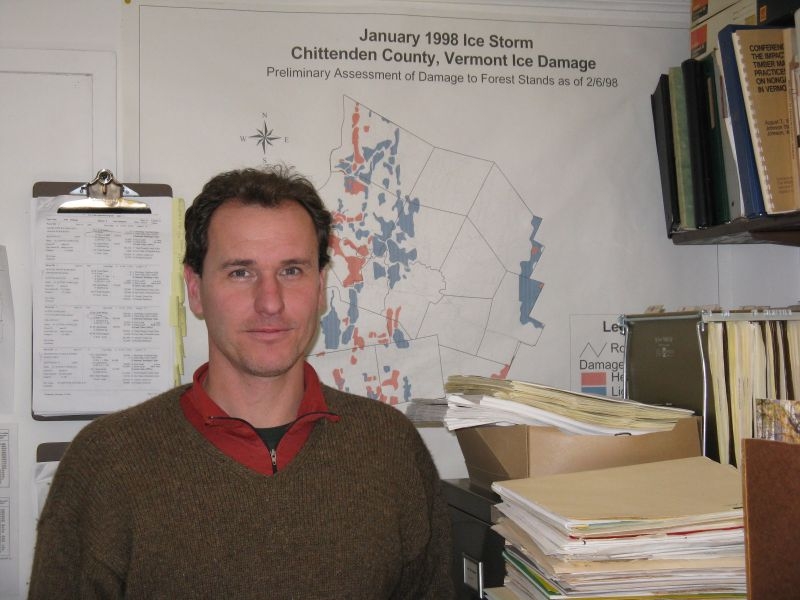 (Host) Ten years ago this week, thousands of trees began snapping and falling across 700,000 acres of Vermont’s forests.
(Host) Ten years ago this week, thousands of trees began snapping and falling across 700,000 acres of Vermont’s forests.
Ice built up as much as five inches thick on trees and utility lines as a relentless storm lashed the region.
So many trees fell, that Vermonters wondered how the forest would recover.
As VPR’s Ross Sneyd reports, that recovery continues.
(Sneyd) In Mike Snyder’s office a fading, dog-eared map tells the story.
Snyder is the state forester for Chittenden County. His map looks like a piece of abstract modern art. Red and blue blotches mark the worst of the storm’s damage to the area’s forests.
Snyder says he’s kept the map on his wall these ten years as a reminder of how stunning the storm was to the trees. And, in some sense, how valuable it was.
(Snyder) “Many people called just to say, `Are my trees going to be OK?’ And, `What happened?’And, `Why is this?’ … Literally years of people calling with questions about their trees recovering from the ice storm or not recovering. You can’t put a price on that. That contact with people. Helping people become connected with their land. That’s a really good thing. And it has a ripple effect through their children and their neighbors, how they see their woods. And I think that’s kind of the silver lining in all of this.”
(Sneyd) That’s not to underestimate the damage.
In some places, crowns of huge, decades-old trees simply collapsed under the weight of all the ice.
Some of them were so badly damaged that, today, all you can see is the graying trunk, dead and decaying.
But beneath them, with no big canopy of shade, new trees are reaching toward the sunlight. The piles of fallen limbs and branches created new wildlife habitat.
Other trees looked as though they wouldn’t make it in the first year or two after the storm. But their damaged branches recovered and they’ve begun to grow again.
(Snyder) “Ten years later, the fun is in seeing this recovery. … I remember talking to people and saying, `Relax, it’ll be OK. This is normal. Trees are incredibly tough. This is a big loss for you. But in the long term the forest is going to be just fine.’ My sense is that’s been not just proved to be true, but probably even more than we thought. We were surprised by some of the recovery that happened.”
(Sneyd) The storm also has been a teaching tool for people involved in forest ecology.
John Shane, chairman of the forestry program at the University of Vermont, says Western forests frequently are devastated by fires.
(Shane) “In Vermont and in much of New England our forests tend to be subject to disturbances that occur on much smaller scales. A few trees being hit with an insect attack. A few trees succumbing to a drought. Maybe a couple of acres burning. Sometimes they call our forests the asbestos forests. We just don’t have large scale disturbances like that.”
(Sneyd) Now Vermont has hundreds of acres of trees that all started growing at the same time.
But that’s not expected to dramatically alter the forest ecology because insect attacks, droughts and small fires will continue.
So the growing forests will likely revert to form. Some big trees. Some new saplings. Plenty of sugar maples and ash and birch.
For VPR News, I’m Ross Sneyd.
VPR Photo/Ross Sneyd: Mike Snyder stands in front of a map of ice storm damage.